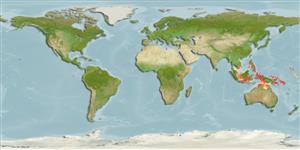Common names from other countries
>
Gobiiformes (Gobies) >
Gobiidae (Gobies) > Gobiinae
Etymology: Trimma: Greek, trimma, -atos = something crushed (Ref. 45335); haimassum: Name from the Greek word 'haimasso' meaning stained with blood, referring to the blood-red spot above the posterior end of the opercle in live and fresh specimens..
More on author: Winterbottom.
Environment: milieu / climate zone / depth range / distribution range
Ecologia
marinhas demersal; intervalo de profundidade 7 - 70 m (Ref. 87358). Tropical
Western Pacific: from Indonesia (SW Sulawesi) north to the Philippines (Palawan) and eastwards to the Solomon Is., probably also in Palau.
Tamanho / Peso / Idade
Maturity: Lm ? range ? - ? cm
Max length : 3.1 cm SL macho/indeterminado; (Ref. 87358)
Descrição breve
Morfologia | Morfometria
Espinhos dorsais (total): 7; Raios dorsais moles (total): 10; Espinhos anais 1; Raios anais moles: 8 - 10. This species is characterized by having the following characters: a relatively deep body, numerous irregular scales with about 30 lateral rows and over 15 scales in the anterior transverse series, a fifth pelvic fin ray that branches twice dichotomously, usually a somewhat elongate second dorsal spine, no predorsal, cheek or opercular scales, a moderately wide bony interorbital with a fleshy median ridge between the eyes, and a dermal ridge anterior to the first dorsal spine. There is a red spot or elongate blotch above the opercle in live and fresh material, and the dorsal surface of the snout has a reticulated dark pattern, with dark transverse stripes over the dorsal margin of the orbit (Ref. 87358).
Inhabits caves and ledges on steep outer reef slopes (Ref. 90102).
Life cycle and mating behavior
Maturidade | Reprodução | Desova | Ovos | Fecundidade | Larvas
Winterbottom, R., 2011. Six new species of the genus Trimma (Percomorpha; Gobiidae) from the Raja Ampat Islands, Indonesia, with notes on cephalic sensory papillae nomenclature. aqua, Int. J. Ichthyol. 17(3):127-162. (Ref. 87358)
Categoria na Lista Vermelha da IUCN (Ref. 130435)
CITES (Ref. 128078)
Not Evaluated
Ameaça para o homem
Harmless
Utilização humana
Mais informação
Nomes comunsSinónimosMetabolismoPredadoresEcotoxicologiaReproduçãoMaturidadeDesovaFecundidadeOvosDesenvolvimento dos ovos
Idade/TamanhoCrescimentoComprimento-pesoComprimento-comprimentoFrequência de comprimentoMorfometriaMorfologiaLarvasDinâmica larvarRecrutamentoAbundância
ReferênciasAquaculturaPerfil para aquaculturaEstirpesGenéticaElectrophoresesHereditariedadeDoençasProcessamentoMass conversion
ColaboradoresFotografiasStamps, Coins Misc.SonsCiguateraVelocidadeTipo de nataçãoÁrea branquialOutras referênciasCérebrosVisão
Ferramentas
Relatórios especiais
Descarregue XML
Fontes da internet
Estimates based on models
Preferred temperature (Ref.
115969): 28 - 29, mean 28.5 (based on 82 cells).
Phylogenetic diversity index (Ref.
82804): PD
50 = 0.5000 [Uniqueness, from 0.5 = low to 2.0 = high].
Bayesian length-weight: a=0.01023 (0.00477 - 0.02194), b=3.02 (2.84 - 3.20), in cm Total Length, based on LWR estimates for this (Sub)family-body shape (Ref.
93245).
Fishing Vulnerability (Ref.
59153): Low vulnerability (10 of 100).
